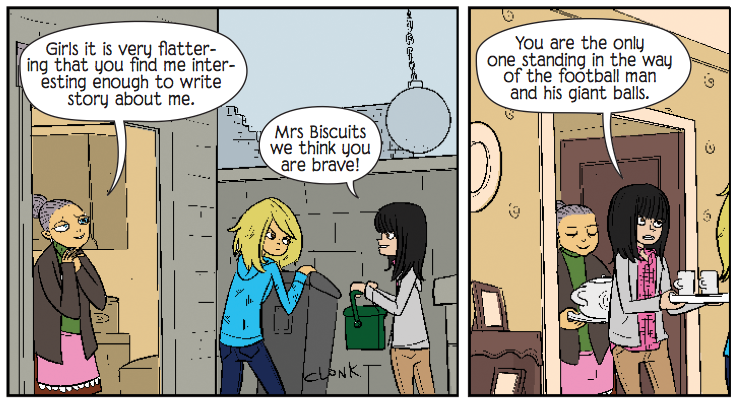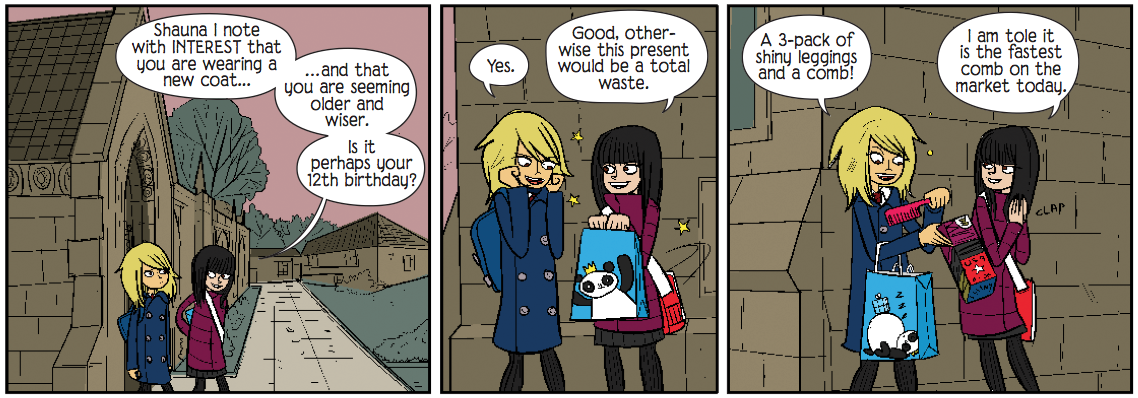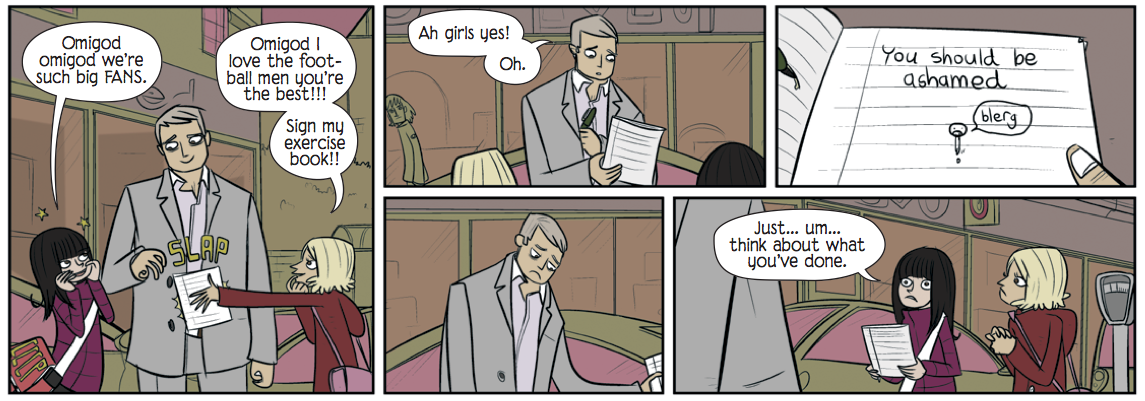Bad Machinery Volume One: The Case of the Team Spirit. Football! A comic with football in it. The World Cup’s still on!
Bad Machinery is a comic from John Allison, who should be hailed even more loudly than he already is (I mean, I assume that he is? I take it for granted) for the wicked, saucy rascals he creates.
It’s online in full, free to read; the sort of webcomic you couldn’t call a timesink because it’s just too enriching. To suggest that your time could be better spent elsewhere would be spitting into the face of culture: rude. But if you’re not comfortable reading from screens at long stretches, good news! The first two case arcs (Team Spirit, and The Case of the Good Boy) have been collected and printed by Oni Press. I’m excited to tell you very intensely what’s so good about the first.
Bad Machinery follows a handful of, at start of volume, eleven year olds. New school year, new school, new classes, uniform, teachers . . . new era. You remember how that feels? I sure do, but then my new school blazer was striped sky blue, yellow, and purple. I call that “unforgettable.”
Even if you don’t empathise with the specifics, you’ll get the gist.
These bright young things are full of piss and vinegar, and they are ready to continue the pastime they have, we are given to believe, made much mischief of in the past: solving mysteries. But mysteries do not just happen! One must find one’s bearings and get used to the new environment. Feel out what big school is like. (If you don’t know your new normal, how can you spot a mystery?)
This is the third title in Allison’s webcomics career, set once again in Tackleford, a town of indeterminate size. Ryan Beckwith, a character whom long-term or lapsed Allison readers will remember (he’s married now! He married Amy!), has evolved into a secondary school teacher, Form Tutor to half our cast, providing a bridge between the old, old establishment of “school” and the young, young rapscallion protagonists. He can speak, or at least recognise, their language, see the reason in their curiosity, and fear them as the New Youth. We never stop coming of age.
Bad Machinery without Ryan would still be superb, and he’s by no means a pivotal character this time scary go round, but oh, I’m glad, so glad that he’s there.
John Allison creates his pages as strips for individual release. Eight Bad Machinery cases can be read online; only two have been printed so far. They translate to long-form stories seamlessly, there are no problems with looking at them as a collected whole. It’s tremendous that a creator can divide a long-form story into page-length episodes, and have each piece register as it’s own, lone triumph. Every page is funny. Every page sings character. I’m not going to show you any full pages, and I want you to allow yourself to be impressed with how good even these tiny slices are:

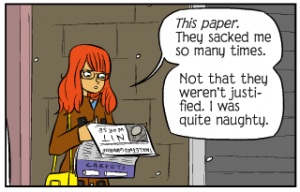 Something you might notice about these excerpts is that they are all featuring Shauna and Charlotte (Lottie). Shauna and Lottie being sharp, funny, mean, bold, insightful, clever, hedonistic, impressed with themselves, bolshy, etc. Did you clock that they’re button-cute? I have this whole song about how Allison’s earlier character Shelley Winters was the rope that dangled into my pit of rage to help me haul myself out of a terrible reactive crossness I didn’t understand—Allison makes his girl and woman characters cute, and pretty, and stylish, and in fact limber, but the things they do are so enjoyable and robust! He makes such ridiculous, whimsical, steel-nerved scandal-courtiers and lets them fuck about with language and tell good jokes, that in young-and pre-adulthood I found myself at the beginnings of an understanding: while being pretty or cute might be integral to an observer’s perception of a woman, it does not have to be the focus of their lasting impression. Being a sweetiepie doesn’t have to trap you into passivity or disempowerment. The opposite of radical, maybe, but revelatory and liberating when you’ve missed that option. Which I had.
Something you might notice about these excerpts is that they are all featuring Shauna and Charlotte (Lottie). Shauna and Lottie being sharp, funny, mean, bold, insightful, clever, hedonistic, impressed with themselves, bolshy, etc. Did you clock that they’re button-cute? I have this whole song about how Allison’s earlier character Shelley Winters was the rope that dangled into my pit of rage to help me haul myself out of a terrible reactive crossness I didn’t understand—Allison makes his girl and woman characters cute, and pretty, and stylish, and in fact limber, but the things they do are so enjoyable and robust! He makes such ridiculous, whimsical, steel-nerved scandal-courtiers and lets them fuck about with language and tell good jokes, that in young-and pre-adulthood I found myself at the beginnings of an understanding: while being pretty or cute might be integral to an observer’s perception of a woman, it does not have to be the focus of their lasting impression. Being a sweetiepie doesn’t have to trap you into passivity or disempowerment. The opposite of radical, maybe, but revelatory and liberating when you’ve missed that option. Which I had.
There are brights in the Bad Machinery palette, Holly and Rowan red and orange, blue-sky blues and varied greens of the choicest, sun-after-rain grass. They hang jauntily against the Biba-sludge “Auntie colours” backgrounds in exactly the same way that a Christmas wreath hangs against an English winter. It’s comfortable, comforting, inspired energy with the sense that once you get home things will be cosy.
But I promised you football!
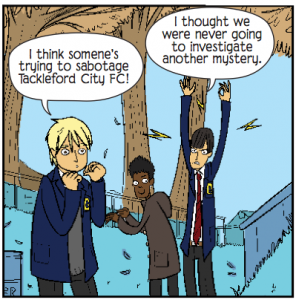 These teens are keen to solve mysteries, yes. And the first one they find happens to revolve around the local football club. This club is owned, as I believe is often the way, by a very rich man who grew up elsewhere and came immigrating later in life to pump money and prestige into some British club in exchange for resentment, local blame, and tabloid hassle. It’s much more football as a cultural presence than football as an actual sport, as seen in Keeper, which is good for me because it means I can understand and actually care about some nostalgic elements. For yes, when I was nine, indeed football stickers were the happening fad. Got, got, need—
These teens are keen to solve mysteries, yes. And the first one they find happens to revolve around the local football club. This club is owned, as I believe is often the way, by a very rich man who grew up elsewhere and came immigrating later in life to pump money and prestige into some British club in exchange for resentment, local blame, and tabloid hassle. It’s much more football as a cultural presence than football as an actual sport, as seen in Keeper, which is good for me because it means I can understand and actually care about some nostalgic elements. For yes, when I was nine, indeed football stickers were the happening fad. Got, got, need—
I can’t help it, I get a little tingle.
The kids wind themselves into the troubles and hopes of the club’s owner, as well as the sweet little old lady (OR IS SHE) he’s trying to force out of her home to make way for a planned new stadium. There are dilemmas, misunderstandings, and the absurdist horror trappings that have always made Tackleford seem so real to me. These people don’t lose any of their true-life worries or get off easy because the trouble can be blamed on a ghost or an alien or an alien ghost. They just take the sort of questions that we might idly ask—if you met a fish-man who couldn’t take care of himself, would you sneak him home in a hoody?—and answer them for real in the course of their generally mundane lives.
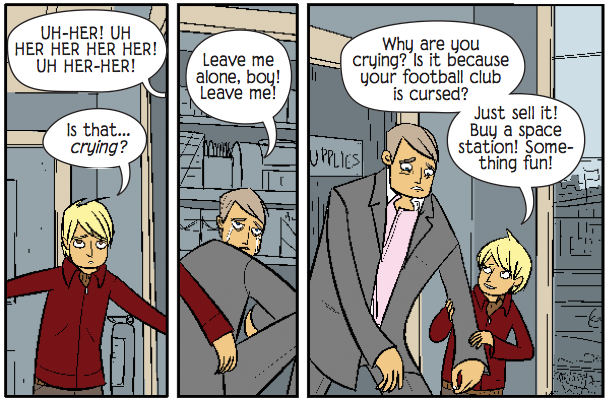
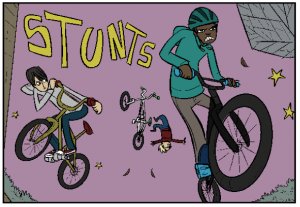 I like genre fiction because it doesn’t reject the fanciful notions that people tend to take. Is it true to life to miss out on people actually being robots, or torture by cabbage odour, or STUNTS? No. My life involves these things, if not literally, and finding a story without them is bizarre and often deadening. It’s not natural to me to draw a line and say “aaah, this could never happen, it is too strange, too unlikely, too magical.” Why would I want to limit myself to a textbook world? If fiction is telling me things are impossible, I’m throwing it in the bin. That is not what I’m here for. Realism should be fantastic because it is fantastic to be real.
I like genre fiction because it doesn’t reject the fanciful notions that people tend to take. Is it true to life to miss out on people actually being robots, or torture by cabbage odour, or STUNTS? No. My life involves these things, if not literally, and finding a story without them is bizarre and often deadening. It’s not natural to me to draw a line and say “aaah, this could never happen, it is too strange, too unlikely, too magical.” Why would I want to limit myself to a textbook world? If fiction is telling me things are impossible, I’m throwing it in the bin. That is not what I’m here for. Realism should be fantastic because it is fantastic to be real.

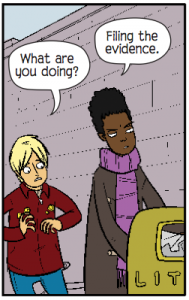 Are you the kind of person who’ll go to the beach and tell a teenager to stop dreaming because selkies (that’s a later story) aren’t real? Get away! Bad Machinery, in the Allison tradition, acknowledges imagination, magic, and the magic of science. These things don’t stop school kids being grotty or snotty or raise them above their class problems, their racial problems, their love problems, their pettinesses, or their friends-shit-on-friends humour. They coexist with them, they provide experiences beyond or during them. It’s just divine.
Are you the kind of person who’ll go to the beach and tell a teenager to stop dreaming because selkies (that’s a later story) aren’t real? Get away! Bad Machinery, in the Allison tradition, acknowledges imagination, magic, and the magic of science. These things don’t stop school kids being grotty or snotty or raise them above their class problems, their racial problems, their love problems, their pettinesses, or their friends-shit-on-friends humour. They coexist with them, they provide experiences beyond or during them. It’s just divine.
It helps that the character design is top notch. I’ve been harping on this for years but man, man, John Allison knows how to create a person. He’s transparent about being a people-watcher, a follower of fashions, and keeping up with music probably helps (people play it, you know? They’re in the videos and that). There are subtle details in the decisions made about every character at their current age (Shauna’s big hair, Mildred & Sonny’s matching cousin noses, Jack’s posture), but when a character is seen during a different period of their life . . . the sun hits a gap in the ozone layer, and we are all burnt to death by its brilliance. John Allison’s not afraid to make people look different from themselves. That’s the thing.
Left and right panels: same guy! Couple of decades between them. Gorgeous. Twenty years of story, told, in the vague details we’ve gleaned from the dialogue so far being imposed upon the teenage stud on the right, because we know that together, they make the worn-down business leader on the left. That’s such a finesse move! I won’t get carried away with rhapsodising, but if you’ve been reading Bobbins NOW, talk to me about Eustace “The Boy” Boyce, yeah?
Nor is Allison afraid to fool us into believing that characters are doing things. Bad Machinery is a dialogue comic, Scary Go Round and Bobbins were too. They’re about people talking, because there aren’t too many ways to navigate relationships outside of language. They talk about schemes, and actions they’re taking/have taken/will take, but the bulk of the story is offloaded by way of verbal exchange, and a graphic artist will not necessarily know what to do with scenes of that nature. We can all name a strip where two chumps stand still gesturing at each other under full balloons, or one chump performs a monologue during a fastball special. Observe this scene:
We’re in the home of the gentleman, which the lady is filling with objets d’art. We’ve seen some of them in pages surrounding these panels, we know what’s up. Here we have the sense of continuing action; small progressions of manual labour from Amy, while her client fannies about being useless with a newspaper. He’s preoccupied and unhelpful, she’s matter of fact and active, not afraid to take charge in someone else’s property. The characters are moved about the space they’re supposes to occupy, we don’t get bored of the background and we’re subconsciously aware of time passing, live continuing, the day being got on with. We don’t see precisely what Amy’s carrying or what is so interesting in that newspaper, but do we need to? Or would that be distracting, and a bore?
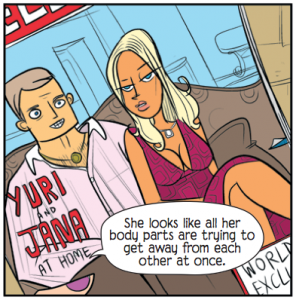
I guess it’s clear that I have a lot of sympathy with this comic. I do, I feel very at home with it. Grammar school, macabre imagination and inclinations towards the mysterious, largely white environment, sort of bumpkinous. I’m not blind to the shortcomings the strip has representationally. I can say it mirrors my school experience in that sense. That’s not something I’m glad of, it’s not something I suggest should be unquestioned. On the same lines, I don’t know why nobody in Tackleford is gay, and I don’t know if it’s a great thing to code Shauna’s bullies as they are. I recognise them from my memories, but I don’t know that I don’t just recognise an old prejudice. I knew girls who wore that aesthetic, and I knew girls who yelled at me that way. Were they the same ones? It was sixteen years ago. I don’t know. I look at this to look at myself.
I keep reading Bad Machinery despite these y/n shortcomings because I know that the responsibility to sort this stuff out is mine. I keep reading because it has so many enjoyable aspects and feels so enriching in other places that I can stand the questions it inspires when I come up for air. I keep reading because it’s familiarity, whilst under inquiry, lets me ask those questions about learnt prejudice and demographics, and dig out old hurts and old spite, and reevaluate the world that I took for granted without understanding it when I was a first year at a country town grammar.
Speaking personally, like I constantly do, I forgive John Allison for writing eleven year old boys talking about how girls don’t understand football because . . . yeah, they do say that, and that’s not always a reason to put nonsense in a story but the meat to be found in Bad Machinery is good enough to transform lines like that into complexity, and opportunity for growth. Expanded character. Or a reminder that we can love people despite their occasional shithead learnt-behaviour lags.
Bad Machinery sometimes hurts, and it certainly might not be for you, but it’s for me. It can comfort me without hiding my faults. It’s mine.
. . . Football . . .






